James Douglas the Pauper
James’s Douglas’s death was not recorded. He was dead by 1841 when the first detailed census occurred. We are really lucky to have two lists of heads of the family of communicants, taken in October 1834 and in 1835. Of course, this would not include people who attended other churches or details of any family.
Both lists include James Douglas, labourer, at Greenfield. Greenfield includes Milnrodgie, Mickle Dounie and Easter Fendoch. The Lethendies are not named on the list.
The Kirk Sessions of Fowlis Wester include several references to a James Douglas who received support as a pauper from the church. For instance, 10 shillings was paid him on August 28th 1825. Another payment was made in April 1832 of 5 shillings and 4 shillings the next April. From April 1835 he is recorded as living at Easter Lethendy and there were 7 payments that year. James received 4 payments next year before the charity came to an end on 15th May 1836, and we may presume that he died around then. It is possible that he actually moved to Canada with relatives but we might expect some sort of application for support in his journey given his impoverished status if that were the case. He would have been around 80 years of age at this time.
Monzie in the 1800s
Forrester (p162) tells us that weavers wove tweed, duffel and plaiding of wool. They also wove fine linen shirts, harn shirts for ordinary wear and for sheets. Tow was spun into sacking and canvas. Scrims or Silesias was a thin coarse linen 27 or 30 inches broad and 92 yards laid. Weavers received a guinea for each piece. It took 24 days to produce one. This time was reduced when the fly-shuttle was introduced, for those who had it. The cloth went from Crieff to Glasgow to be whitened and printed. The Old Statistical Account in 1792 had 7 hecklers and 92 weavers in Crieff, 54 weavers in Monzie and 50 in Fowlis Wester. The census of 1831 did not record the names of people, unfortunately, but does give a snapshot of communities in decline in Perthshire. There were 305 inhabited houses in Fowlis Wester, with 341 families. In all there were 1680 people in the parish, of whom 448 were men above 20 years of age. In Monzie there were 253 inhabited buildings with 1195 people.
There was a slate quarry at Glenalmond for a short time but that at Craiglea was in use for much longer. According to the New Statistical Account of Scotland 1.2 million slates were sold each year from Craiglea. The slates needed carted to Luncarty, Perth, Methven or Crieff. This brought income to local carters and farmers. More about Craig Lea comes below regarding Alexander Duncan.
There were three schools in the area, at Chapelhill, Harrietfield and Ballandee. Harrietfield or Castlehill are the likely places where the young Douglases and their relatives were taught, being close to Milnrodgie and the Lethendies.
Children were taught reading, writing and arithmetic. All reading came from the Shorter Catechism and Book of Proverbs for beginners; the New Testament and Old Testament for those more advanced. Arithmetic may have been taught and Religious Instruction was the most important focus of the curriculum. Schools were religious in character, the master appointed by the church. Learning and revising the catechism, learning a Psalm and the subject of that Sunday’s sermon featured strongly (Forrester, p 166-7).
Family of Helen Douglas and Duncan McKerchar:
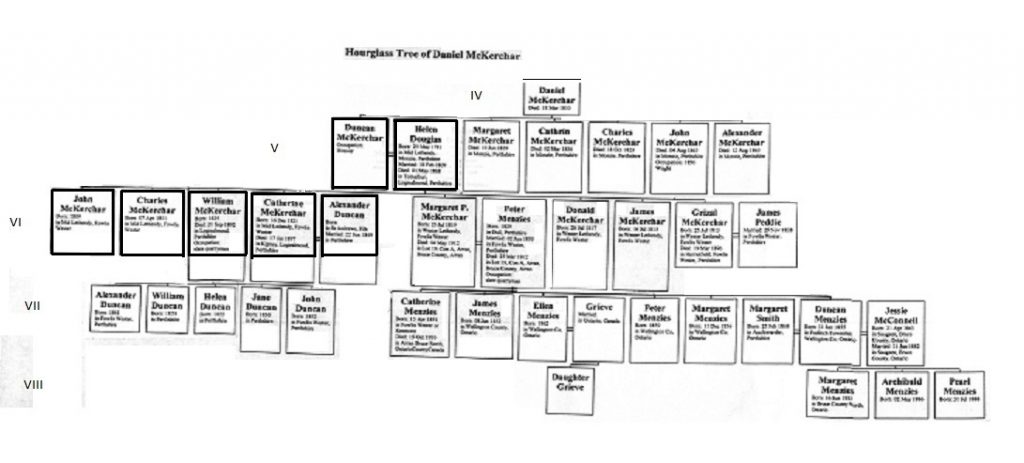
James and Margaret’s only son, Charles Douglas
James’s children appear to have scattered. His only son Charles leaves a sketchy record behind. All I really knew of him until recently was that he was a labourer of some sort, according to the registration of his son’s birth. According to Forrester (p156) labourers had a severe life. Their jobs might include working in the slate quarry or driving the slate to market; helping with the harvest in their own area but also with early or late harvests elsewhere; cutting peat; selling heather.
He says they would have eaten simple food grown themselves and lived in simple houses built by their own hands with stones hauled from the moor on sleighs, mortar from clay on the spot, thatched roof of heather or rushes rather than straw. The fire would be peat. This gives a bleak account and perhaps is accurate for labourers of long standing over several generations. I find it hard to believe that Charles Douglas was cast out so when he had sisters living in the area. it is more likely that he continued to live in a ferm-toun house with one of these families.
Recently I found that in May 1811 a 17 year old Charles Douglas, labourer of Monzie, had joined the 2nd Battalion, 71st Regiment. A description was recorded, as follows. He was 5ft 7.5 inches tall, had a brown complexion, black eyes and brown hair. Charles was in the 3rd company. I’m confident that this is our man- and we have a description as well!
Having spent time researching the 71st Highlanders and finding they had fought at various battles in Spain and France and even at Waterloo I was brought down to earth with a bump! Charles did not enjoy a long and distinguished military career! He was scarcely in it long enough to buy the uniform.
For some reason he was discharged on 23rd June 1811: he had been in the army only 7 weeks! Still, we have a description of an ancestor from this. One intriguing aspect is that he is said to have joined at Newcastle! What can have taken him there in the first place? And did he join the army to get a lift home? Had he been a civilian labourer assisting with transport? If he was so far afield perhaps he may yet turn up in other records in England after all.
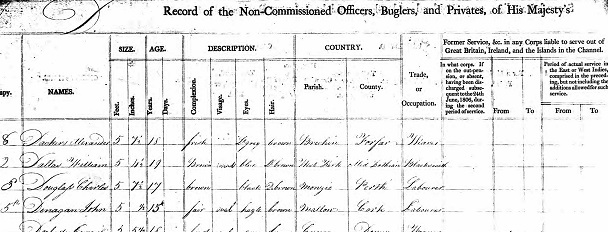

Charles died or disappeared before the 1841 census. Apparently he married a Janet Haggart or Haghart from Monzie and they had a son called Charles, born in December 1816 and baptised in January 1817. It is interesting that the son’s birth and baptism are both recorded. Maybe this was to ensure that there was no doubting the child’s legitimacy. Their marriage was either not recorded or the record was lost. Maybe they married informally or irregularly.
The excerpt below is taken from Henry Hildyard’s History of the 71st Regiment. Charles joined in May, apparently at Newcastle. Did that mean the ships had stopped off there on the way further south? Where was he discharged from- if it was Southern England, how did he make his way back to Monzie? After all, he seems to have been there in 1815.
On the 15th of May, 1811, the second battalion[82] embarked at Leith for South Britain, arrived at Ramsgate on the 23rd of that month, and remained stationed in England for nearly two years.
A marriage by declaration at a hearth before witnesses was legal until around 1914 in Scotland, though frowned on by the church. The two people just made a simple declaration at the hearth of their home, saving money on the banns. Maybe Janet was pregnant and they needed to act quickly. However the Kirk Sessions for both Fowlis Wester and Monzie do not record any investigation into her pregnancy (meaning they pre-empted this), no rebuke in church to either of them for fornication and no rebuke for an irregular marriage. There are examples of all three of these occurring. We will find one very shortly.
It’s just possible but very unlikely that they married while Charles was in the army at barracks. But you’d still expect banns read at the bride’s church- and she was around 14 at that time; also if he joined in England it is very unlikely that Janet was there, too.
There is one more glimpse of Charles in the records. Forrester tells us the church would try to find jobs for people struggling. The OPR Kirk Sessions for Monzievaird and Strowan for Feb 1815 (CH2/654/3) includes an inquiry into a pregnancy outside marriage with Charles Douglas, teacher at Kinnochraggan, giving evidence. I have read of cases in Ireland in the 1850s of teenaged men employed as teachers and through Forrester of poor or young people employed as teachers in a parish. It seems likely that this is “our” Charles. “Mr Cameron reported that Alexr Allan Innkeeper at Kinachraggan on Wed last the 31st waited on him, and acknowledged before Charles Douglas Teacher there and that the said Alexr Allan is the father of Ann McPhailes child.” (CH2/654/3 Monzie Kirk Sessions)
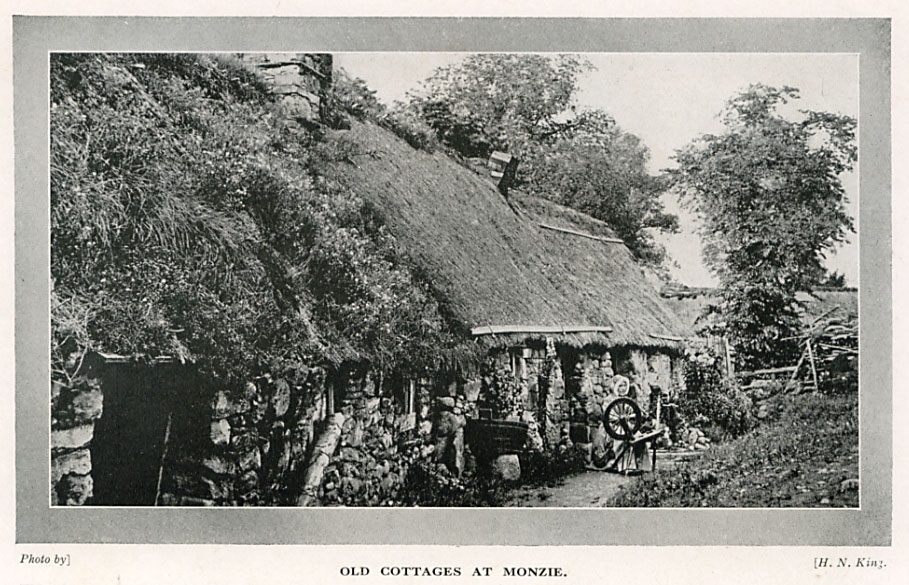
Old cottages at Monzie, Perthshire in the 19th century From the Happy Haggis website, http://www.google.co.uk/url?sa=i&rct=j&q=&esrc=s&source=images&cd=&cad=rja&uact=8&ved=0CAYQjB0&url=http%3A%2F%2Fwww.happyhaggis.co.uk%2Fperth.htm&ei=iDoDVc68E-jk7AantYCwDQ&bvm=bv.88198703,d.ZGU&psig=AFQjCNGmlml7l90WmpINdkFugeoW6oyNuQ&ust=1426361355745095
October 2019. I should point out that there is clear DNA evidence of the validity of my research into the late 18th and early 19th century Douglases, with DNA making connections between myself or my father and several descendants of Helen Douglas as well as descendants of Margaret Douglas. I have not yet made connections to descendants of Grace Douglas but it may be that there is a lack of descendants taking the test.
Monzie in the 1800s
According to the Statistical Account of Perthshire, vol X, p260 there were 24 people in Fowlis Wester on average receiving parchial support of around 4 shillings a week around May 1837. The Account for Monzie notes the decline in the number of people living on the land in that parish, with more in Gilmerton village and a trend towards larger farm holdings. It also says that Gaelic was spoken in western Glenalmond and Scots dialect with a Highland accent in the rest of the parish. The minister writes that few understand Gaelic in the southern districts.
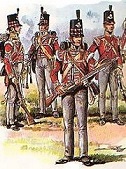
Picture of 71st Highlanders from: www.napolun.com site
What else could have become Charles Douglas, born in 1792?
This is something unlikely to be resolved. In the early 19th century deaths were not recorded. Burials might be but often the focus was on the sum of money raised as a result for the parish- not the identity of the dead. My understanding is that most grave markers would have been wooden, which would perish. I stand to be corrected on this. In some cases- Charles’s very son being an example- the family lacked the means to pay for a grave and the deceased was laid in the common plot for the poor with no marker.
My belief is that Charles died sometime unknown between January 1817 and 1825 when his father James was given his first payment by the parish. Indeed, it is possible that the sum given was partly to cover Charles’s burial. This is speculation, of course. It would also be speculation as to how he died.
There are other possibilities:
Charles rejoined the army and went off either to make a new life or to die outside the parish. Army records are quite good and there is nothing to suggest enlistment in another regiment. I think recruits would be asked if they had previously served.
Charles left his wife and child to work elsewhere, with his identity possibly forgotten soon and hs burial place unknown. This is quite possible but can not be demonstrated or refuted.
Charles deserted his wife and child and carved out a new life for himself elsewhere. This is certainly possible – especially if he went abroad. I did take steps to find Charles on the 1841 census, looking for a Charles Douglas born in Perthshire around 1792. I found three which I then explored further by tracking the subsequent 1851 and 1861 censuses and then looking back to try to verify births or marriages or deaths.
The first was a Charles Douglas, twin of William Douglas, living in George Inn Lane in Perth. Both were shoemakers, a trade unlikely to have been started up by an adult man, and of course “our” Charles lacked a brother William.
The second lived at Lodpetrie Toll in Dowally and was aged 46 (10 years later he was 62). He had a wife and 5 children, one of who was only a few days old. Following them to 1851 home was the toll at Moulinarn. For this census respondents were invited to give their parish of birth. This Charles, unfortunately, said Logierait, although in 1861 he said Moulin. His birth may be traced to 25th September 1794 in Logierait to Alexander and Isobel Douglas or to John Douglas and Janet Moncrieff on 4th May 1787 in the same parish. I did find his wedding, to Jean Campbell of Dowally in 1830. Thus, this is not “our” Charles, either.
The third one was the most intriguing for me because of the coincidence of place. This was a Charles Douglas, aged 50 in 1841, living at Polnoon Street in Eaglesham. He had a wife Janet and 8 children. This Charles was a cotton spinner, born in Scotland.
In 1851 he said he was 56, was a superannuated cotton spinner and had been born in Stanley, Perthshire. There were 6 children at home. They were living at 33 Polnoon Street.
Checking forward, in 1861 he was now 67, confirmed his birth in Stanley and was unfit for employment. I traced his marriage to Janet Young on 27th October 1820.
It seems, then, that none of these men is Charles Douglas, born in Monzie in 1792. There are others out there in England but I see nothing to demonstrate a likelihood of connection to our fellow. My conclusion remains, therefore that he probably died at some stage in the late 1810s or 1820s.
Fear of Revolution
There was fear of revolution in Perthshire in the 1790s, leading to a Militia Act in Parliament. There was public anger and attacks were made on or threatened against the schoolmasters charged with making the lists of eligible men (Chronicles vol iv, p160-163). Apparently it was hoped that Logiealmond would be quiet but the session books were sent to Perth to be safe (same, p167). There was a mob from Crieff, apparently, intent on seizing Murray of Ochtertyre’s lists and session books. Ochtertyre had men to ward them off, however.
At one stage two squadrons of light dragoons were quartered in Crieff in 1797 under the Major General Campbell of Monzie. Fear of invasion in 1803 led to militia being called out, mustering at Perth.
We have no list of men impressed but if this letter is anything to go by James Douglas and his relatives may have been involved:
The following account was given of the dinner which took
place after the review by Mr. Blair, merchant in Dunkeld, who
was a guest on the occasion :
Mr. Blair to Mr. Pallisser.
Dunkeld, 8 Nov. 1804.
Dear Sir, … I may now inform what you will readily believe,
that this City is now like a deserted Village. The Family gone, and
Volunteers in Perth, where I also have been these last two days. The
spectacle on Tuesday was really grand. I saw your 1st Lieutenant 1
employ’d in giving you particulars, but he was not to finish his letter
untill after dinner, as he concluded he would then write with more spirit,
and doubt not but he might.
(from Chronicles of the Atholl and Tullibardine Families, vol iv, P210)
Margaret’s Family- The Christons
The name Christan or Christon is unusual, presumably nowadays it is “Christian”. No document calls Margaret “Crichton”, however, despite what LDS record says. The LDS record is the vast compilation of genealogical data created by the “Mormon” church. Their microfilm records are available at local church branches, I believe, and they are most accommodating of visitors. The Christons lived in Monzie area before 1700 – Donald Christon was an elder of the church in 1703. It seems likely that he was related to Margaret but I have not attempted to research this branch in depth yet. Another Donald Christon, or the same, was unanimously chosen as box master in middle Lethendy in 1725 according to the Monzie minutes.
The Duke of Atholl’s list of militia included three Christians at Middle Lethendy in 1706: Donald the elder and Donald the younger and William.
In 1712 Donald Christon, the church elder, was given 12 shillings. A reason was given but I cannot read it. It was not poor relief. Thomas Criston married Jannet Drummond in June 1725.
On 6th November 1726 William Criston were proclaimed and married.
On July 2nd 1723 Donald Christon was relieved of poor money. This comes from the Monzie Kirk Sessions of 1711-1731 (CH2/654/2).
A “D Crichton” was at Middle Lethendy in March 1805 as seen above. Was this the same dwelling as the Douglases had lived at? A widow Christan was buried in May 1818, the mortcloth costing 1 shilling.
Another variation on the name- daughter Helen’s death certificate says her mother’s maiden surname was “Gilchrist.”
Charles Douglas, 8th Company, 71st Regiment of Foot
Hard Times in Perthshire
Farming life was becoming harder in Scotland. There were several years of little rainfall after seeding (1800-1, 1811-12, 1816-17 and the years 1823-26 were described as catastrophic
(Forrester, p 155-56). A factor recommended rents to be reduced by 1/3 but this was not enough to relieve the pressures. More and more Scots, many from Perthshire, left Scotland from around 1818 onwards, especially in the 1830s. Some were given assisted passage by the churches to help reduce the long-term pauper payments.
Generation V: Family of James Douglas and Margaret Christon
1. Helen Douglas, 1781-1868
2. Margaret Douglas, 1783-1856
3. Isobel Douglas, 1785-1883
4. Grisals or Grace Douglas, 1789-1879
5. Charles Douglas, born 1792
Floating Douglases
I don’t like to withhold information. There are Douglases out there that I cannot tie in to our tree. The 1841 census has two boys, aged 13, named Andrew Douglas and David Douglas. Both were agricultural labourers, one at Francesfield and one at Declater. Both were born in Perthshire.
Thirteen might mean 15 on the 1841 census. Either or both could be inaccurate. These could both be- or one could be- sons of Charles Douglas and Janet Haggart. Or they may hint at other Douglases, related or otherwise, in the area. I have had no success finding them in later census returns (which would tell us the parish they were born in) or on BMD. Their existence and disappearance are both mysteries.
I would note, though, that neither Christian name occurred before or after in our family which has been quite careful in observing family names up until the post WW2 period. So on reflection I think these are two itinerant labourers in the area for a season and away again later.
Generation VI: Children of Helen Douglas and Duncan McKerracher
1. John McKerracher, born 1809
2. Charles McKerracher, born 7/4/1811
3. Grisal McKerracher, 25/7/1813 – 19/3/1896
4. Margaret Pearl McKerracher, 25/7/1813 – 4/5/1912
5. James McKerracher, born 16/7/1815
6. Donald McKerracher, born 26/7/1817
7. Catherine McKerracher, 16/12/1821 – 17/1/1897
8. William McKerracher, 1825 – 21/9/1892
William Ritchie Beattie
William Ritchie Beattie was born in 1900 in Christchurch, Canterbury, New Zealand. He became a civil servant and married Lorna Naomi Saunders in 1927. By 1935 they were living at Mauauatu-Wanganai. Their address was 28 Rangitane Street.
Three years later they had moved to 46 Maungakiekie Avenue, Green Lane, Onehunga, Auckland. Wiliam was liable to be called up for service during WW2 as his name was on the ballot used to draw recruits. His number was 466453. I do not think he was called up but perhaps someone out there can tell me better. William and Lorna were living at No 1 Bridge, Raglan, Waikuku at the time. He was described as “Branch Manager- State Advances” at the time. I presume he continued in this role as they remained at this address until at least 1946.
In 1949 they were living at 7 Hinau Street, Hutt, Wellington and remained there on susequent registers up until 1972.

A weaver at work at a home loom in Perthshire in the 19th century; from Perthshire Crieff Strathearn website
James and Margaret’s Daughter Helen
James and Margaret’s daughter Helen Douglas remained in Perthshire, marrying a weaver named Duncan McKercher in February 1809 and having five children. Monumental Inscriptions were recorded in the mid nineteenth century and one gravestone records details of many McKerchars at Monzie. These seem to be the father and siblings of Duncan McKerchar. I couldn’t find this in 2010: many are badly weathered. Helen’s son Donald was a lodger of the Agnes family at Woodside Road, St George’s, Milton, Glasgow at the time of the 1841 census.
McKercher is also spelt McKerchar, McKerrcher, McKerricher and even McGregor in different indices and records and I have attempted to be uniform here to avoid confusion but it may be that anyone seeking the original records for themselves will need to try variations when they search.
The 1851 census shows Helen as a widow (Census 357/00 007/00 005). Children William and Margaret lived with her; so did Margaret’s husband Peter Menzies and their daughter Catherine*. William and Peter worked at a slate quarry. Also there was a child named Peter Donaldson who is described as a grandson. Maurice Rhodes has researched their descendants (and Peter Menzies’ forbears) in detail. Husband and wife both died in 1912, though there is a discrepancy over Margaret’s birth date on her death certificate.
Helen died in May 1868, her death reported by her son William (SR 375/00 0006). Her age was recorded as 81. She had lived at Tomafour, less than a mile from Lethendy Cottage. As I have not found records of her son James perhaps he emigrated, too.
Catherine McKerchar was baptised on 16th December 1821, having been born at Mid Lethendy. She married a man named Alexander Duncan whilst she lived at St Martins Parish and he at xxxxx, so the banns were read in both places. They went on to have 5 children. More on them below.
Bridget McIntyre in Australia has written to confirm that son Donald emigrated. Donald married a woman named Christina Ritchie on 3rd February 1851. They lived at a place called Stonefield, Port of Menteith in Scotland. Christina made a sampler which has survived 160 years. I suppose many women must have produced these artefacts yet few remain. That is a shame given the time and effort which must have gone into making them.
My thanks to Bridget for this picture of the sampler.
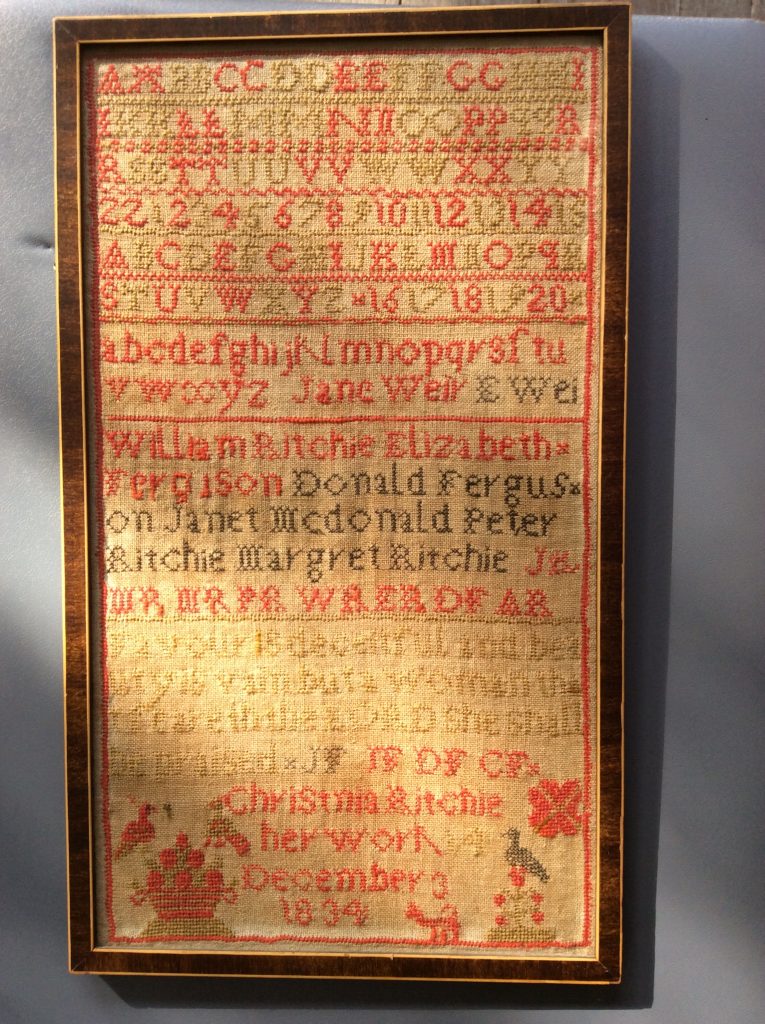
Donald was living at 9 Woodside Road, Milton, Glasgow in 1851 according to Ancestry. He was a shoemaker and a lodger there. His wife was not present at the same address. His birthplace is confirmed as Monzie, Perthshire. On the 1861 census he was living with his wife Christina at 7 Woodside Road. I have seen the original document and can be certain of the house number. By now they had children Elizabeth aged 10, Helen aged 8 and Mary (4). There was a lodger named Donald Farquarson in the house, too.
I have used the OPR and SRs on Scotlands People to clarify and expand on what is known of this family. They had other children- there had been a daughter named Margaret born on 17th December 1854 (OPR 644/0390 0674) and a son in 1861 named Donald, born on 30th September (SR644/07 1271). Father could write his name, albeit with a large hand, as he registered Donald’s birth as well as Mary’s. Mary was born at 7 Woodside Road on 29th April 1857. He described himself as a master shoemaker. (SR 644/07 0536).
Bridget MacIntyre thinks there was another Margaret born in 1859. This may be so but I have not verified this yet as there were 86 possible matches between 1858 and 1860: too expensive to chase up at present. If there were another Margaret it would mean the first one had died.
I was not able to locate Helen McKerracher’s birth in 1852 or 1853.
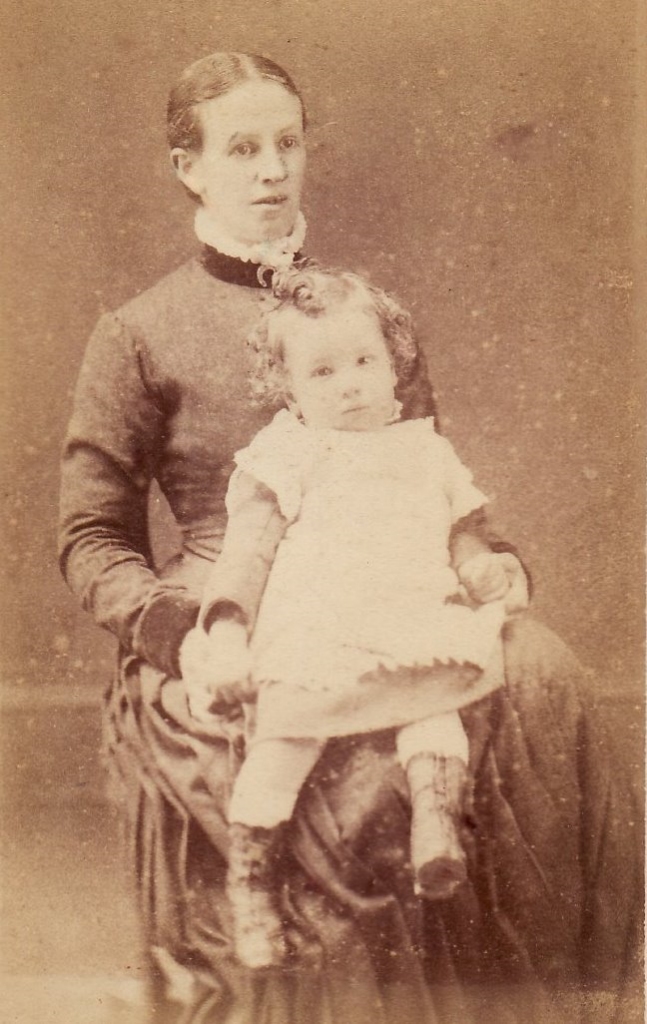
The photo above comes from Robyn Cliff in New Zealand. My thanks to her for this. It is of Helen McKerchar and her son Donald. Robyn dates it to around 1885. Robyn is the grand daughter of Donald Beattie. DNA evidence demonstrates our connection to each other.
The parents were certainly in New Zealand in 1880/81 as Donald is on the electoral roll, living at Colombo Road, Canterbury, Sydenham [if I have this the wrong way round would someone let me know].
Daughter Elizabeth had been born on 16th April 1851 in Glasgow (OPR 644/01 0390 0068) and died at Sydenham, Christchurch, New Zealand on 4th September1924.
Mary had a son named William Ritchie Beattie in 1900 at Christchurch, Canterbury, New Zealand. I have located information about him on Ancestry.
Returning to the family of Catherine Mckerchar and Alexander Duncan, they had 5 children as mentioned above.
- Jane Duncan, born 1850
- John Duncan, born 1852 Fowlis Wester
- Helen Douglas Duncan, born 1855
- William Duncan, born 1858
- Alexander Duncan, born 1861
Cameron Smith has very kindly supplied information as he is a great grandson of Helen Douglas Duncan. She maried John Smith and they had a son named Alexander Duncan Smith in 1894 at Lenzie, Dunbartonshire. Once again we see how families spread away from their traditional home areas in mid to late 19th century Scotland. Once again, also, the information would have been so difficult to locate without this family knowledge provided by fellow researchers and distant family members.
Cameron supplied the following:
“Helen Duncan’s brother, Alexander Duncan, was fondly remembered by my father as Uncle Sandy. I think he was quite the throwback to an earlier era–drinking his tea from the saucer was a detail I seem to recall. He remained in the quarrying business and attempted to open his own quarry, but for geological reasons he needed to secure access from land belonging to the Atholl estate, and that wasn’t granted, so the business folded. We have a letter from the Atholl estate relaying the refusal”.
Helen’s sister Alexander was known as Sandy and he was a slate quarryman in Logiealmond. He worked at the Craig Lea quarry. When it closed down his employer wrote a testimonial letter to help Sandy find work so obviously he was a reliable and well thought-of employee. This seems to have been in early 1889. Cameron Smith thinks that Sandy and his former employer tried to open a quarry near Dunkeld.

Image below from Cameron Smith shows a replacement birth record for Sandy. This says that he had been born on 28th June 1860 at Francesfield in Logiealmond. His father Duncan was specified as a ploughman rather than te generic agricultural labourer found on census records. Sandy had national health insurance via the Rural Workers Approved Society. At the bottom, however, it says that he was born at Tomafour rather than Francesfield. The certificate is dated to 1927.

Cameron Smith also kindly enclosed a newspaper excerpt from the Dundee Courier about an industrial accident sustained by Sandy. It also notes that his son John also worked there. As this was at Craiglea presumably it was before 1889.

I have located newspaper articles from February 1897 regarding an accident at a quarry where Sandy worked. An inquest was held into the deaths of three workers struck by a flying piece of rock from a detonation.

A lot of evidence was presented and it seems that the men were just unfortunate. The cutting below is from the Strathearn Herald of 13th February and tells us what Sandy reported. He was now a foreman. As he said he had been employed for 20 years it does raise the question of whether this was the same quarry but perhaps the owner had sold it and Sandy remained.

However, Sandy was certainly managing a quarry many years later as this advert in June 1924 from the Strathearn Herald indicates that he was living at Kipney and the quarry was indeed near Dunkeld as Camerom Smith informed me. The slate quarry was at Letter Hill and Alexander held the license off the Duke of Atholl who owned the land.

Other newspaper references exist to Duncans at Kipney in the 1990s but I do not know if these are descendants, other relations or others.
Census records show the family of Catherine Duncan over the decades. In 1861 she, ploughman husband Alexander and children Jane, John, William and Alexander were living at house 11 Tomafour in Fowlis Wester (Logiealmond). All the children were said to have been born in Logiealmond, Catherine in Monzie. The next house was the home of her widowed mother. Helen was said to be a stocking weaver aged 73.
The bext two censuses recorded Catherine as having been born in Crieff and that of 1891 says Monzie again. In 1871 the house had two rooms with windows. Alexander was now a slate maker rather than a ploughman. Son John had become a duffer, so he was working in the weaving trade. There is no William recorded in the house.
Come 1881 and 1891 they were living at house 1, Kipney. This is likely to have been a bigger house as it had 3 rooms with a window. Husband Alexander was still working at a slate quarry. Son Alexander (Sandy) was recorded as a clerk and either a slate braker or slate broker. John was not at home. There was a lodger, Henry Purves. His job is hard to read about includes the word slate so presumably he worked at the quarry.
On the 1891 census both John and Sandy were present. There was a fire at one of the Kipney cottages, as recorded in many newspapers, even in England. This was at the house of a farmer named McIntyre. The following comes from the Dundee Courier of 25th October. It is a long report, 4 paragraphs. As always, newspaper exceerpts are copyright to Find My Past.




The 1905 Valuation Records (VR 011300051) show that the land at Kipney, including the quarry, was the property of the Earl of Mansfield. Charles McIntyre lived in the third Kipney cottage and Alexander Duncan in the fifth. Sandy Duncan’s house was valued at £3-12-0. A note in the margin refers to this land having previously been part of the parish of Fowlis Wester but it had changed because of a Boundary Commission recommendation.
Incidentally, Tomafour Cottage had been lying vacant for some years. It was valued at £5. By 1915 it was rated at only £4.